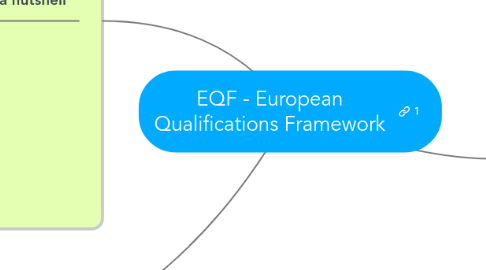
1. linking National Qualifications Frameworks (NQFs) to the EQF
1.1. interoperable NQF databases in Europe
1.2. see Global Inventory of Regional and National Qualifications Frameworks 2019, Volume II for more detail
1.3. in Italy
1.3.1. NQF covers qualifications from general education, higher education and VET qualifications administered at regional level (professional and private qualifications still to be included)
1.3.1.1. upper secondary level: general (licei), technical and vocational education. Each pathway lasts five years and is linked to the EQF level 4
1.3.1.2. NQF level 5 marks the transition between secondary and tertiary education, and – from a labour market perspective – between the production and delivery of goods and services (levels 2 to 5) and the managerial levels (levels 6 to 7)
1.3.1.3. higher (non-academic) technical education: IFTS (one-year courses) EQF level 4 and ITS (two/three-year courses) EQF leval 5
1.3.1.4. QTI framework for higher education: Dublin descriptors used nationally for the cycles of higher education within the Bologna process
1.3.1.5. Euroguidance Italy promotes mobility for learning and training purposes among EU countries. The Italian National Contact Point (NCP) operates within ANPAL - National Agency for Active Labour Market Policies
1.3.1.6. NQF and the role of ANPAL (presentation)
1.4. Find, understand and compare qualifications types that are part of NQFs
2. in a nutshell
2.1. Aim: making qualifications more readable and understandable across different countries and systems
2.2. Qualification = ‘the formal outcome of an assessment and validation process obtained when a competent body determines that an individual has achieved learning outcomes to given standards’
2.3. EQF levels described in terms of KNOWLEDGE (theoretical and/or factual), SKILLS (cognitive and practical), RESPONSIBILITY AND AUTONOMY (formerly named competences
2.4. All types and levels of qualifications are covered, including those resulting from formal education and training at all levels, but also private sector qualifications and international (sectoral) qualifications. Level 1 represents the lowest level of proficiency, level 8 the highest. In principle all possible ways of learning can lead to the learning outcomes corresponding to the eight levels, including non-formal and informal learning. Not all countries have referenced their entire qualifications system to the EQF, despite its overarching character
2.5. covers all levels and types of qualification: from formal education and training (VET, general education, higher education) and from validation of non-formal and informal learning.
2.6. learning outcomes approach
3. implementation
3.1. European Higher Education Area (EHEA - Bologna process): cycle qualifications correspond to the learning outcomes for EQF levels
3.1.1. short cycle (Short Cycle Higher Education - SCHE) - EQF level 5
3.1.2. first cycle (BSc) - EQF level 6
3.1.3. second cycle (MSc) - EQF level 7
3.1.4. third cycle (PhD) - EQF level 8
3.2. Higher VET qualifications are allocated to those NQF levels which are referenced to the EQF levels 5 to 8
3.2.1. These qualifications are *usually* acquired outside the higher education sector
3.2.2. At the foreground of the qualifications provided in higher VET are practical work and experience-based learning, supported or complemented by the theoretical knowledge required for action competence.
3.2.3. main point of reference for higher VET is therefore the respective profession or field of work rather than the academic discipline
3.3. other
3.3.1. e-Competence Framework
3.3.1.1. industry-addressed competence framework: descriptors for IT professional competence (not qualifications): 5 proficiency levels related to the EQF levels 3-8
3.3.2. ECVET - European Credit system for Vocational Education and Training
3.3.2.1. collection of Learning Outcomes developed in past projects and initiatives
3.3.3. World Reference Levels for lifelong learning - UNESCO 2019
3.3.3.1. works by translating sets of learning outcome statements into standardised reports, using a conceptual structure that should be recognisable around the world

